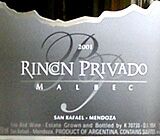|
Attention, Hotmail readers
I've been receiving a large amount of puzzled E-mail in recent weeks from readers using free Hotmail E-mail accounts, indicating that our HTML/Graphics edition is now appearing as "gibberish." Assuming that this complaint pertains to a technical issue and is not a critical evaluation of my prose, I'm trying some changes today that I hope will clear up this issue. (Graphics-edition readers using other mail systems may notice slight changes in fonts and formatting, but these should be minor.) If you're using Hotmail and happen to notice that this move does (or doesn't) correct a problem, please let me know. Malbec and earth Regular readers will know that I'm a fan of Argentine red wines based on the Malbec grape. But Malbec doesn't get much respect, to the extent that a wine-loving friend, talking about the grape in a recent E-mail, asked frankly, "Is it a plebeian wine?" Just to be on the safe side, I went to the dictionary to look that one up: "Of or relating to the common people of ancient Rome: a plebeian magistrate," and, thus, "Unrefined or coarse in nature or manner; common or vulgar." Well! Let's put it this way: Argentine Malbec is usually cheap. It's one of the few varieties where you can find a lot of choices for less than $10, and darn few (well, OK, Altos Las Hormigas Riserva, but it's worth it) for $20 or more. So, sure, a lot of people equate cheap wine with poor wine, but I'm not prepared to make that knee-jerk assumption without a little tasting. Malbec also may suffer because of its history in France, where it's traditionally listed as one of the five permitted grapes in Bordeaux (along with Cabernet Sauvignon, Merlot, Cabernet Franc and the less familiar Petite Verdot), but where it has become all but unknown in modern times, rooted out to make room for more "desirable" vines. (It's still grown as the predominant grape in Cahors in Southwestern France, but Cahors isn't exactly a popular item nowadays, either.) I've occasionally tried to quiz Bordeaux producers about this, out of curiosity, but they usually squint at me with a pitying look and a simple "Non." As best I can determine, the grape simply isn't seen as filling any need in Bordeaux, adding nothing much to the blend that Merlot can't. But in Argentina, Malbec is the go-to grape, and I find that it consistently makes a decent, even interesting wine that usually comes with a low-end price tag. It goes very well with a variety of foodstuffs, making a natural match with beef (another top product of Argentina) but also marrying nicely with cheeses, poultry, and, in a surprisingly delicious way, with pizza. Pondering these weighty matters the other night, it occurred to me that cheap Malbecs often appeal to me in a way that other inexpensive New World wines don't always do because Malbec, almost alone in its market niche - isn't only about fruit. Although its fruit is usually forward and easy to enjoy, it almost offers a pleasant earthiness, a hint of clean, moist clay that suggests a sense of place in a distinctly Old World way. If you find it hard to visualize a desirable aroma or flavor component in wine that's reminiscent of mud, let's consider an analogy that, for me, helps explain minerality in wine: We recently endured a 39-day late-summer drought in these parts, a dry spell that finally ended with long and heavy rains last week. Now, think about walking outdoors after such a drought-breaking rain, and watch the clean runoff water trickling down over hard-baked clay and dusty limestone. Take a deep breath. Remember that fresh, aromatic, earthy smell? When I pick up an aroma like that in wine, it pleases me in a deep and compelling fashion that's much more emotional than rational and that takes me back a very long way. This scent of the earth makes an appealing adjunct to simple fruit, and I consistently find it in Malbec. Here are my tasting reports on a trio of modest Malbecs that I've enjoyed recently, two tasted analytically at home and the third in a more social encounter in an excellent new local Cuban restaurant, Havana Rumba in Louisville.
TALK ABOUT WINE ONLINE If you prefer to comment privately, feel free to send me E-mail at wine@wineloverspage.com. I'll respond personally to the extent that time and volume permit.  San Telmo 2003 Mendoza Malbec ($7.49)
San Telmo 2003 Mendoza Malbec ($7.49)
This very dark reddish-purple wine blends earth and fruit, ripe plums with a distinct whiff of "clay" as a background note. Juicy and tart, plummy fruit and lemony acidity add a hint of tannic "fuzz" in the background, and pleasant mineral notes lingering with fresh black fruit in the finish. Surprisingly complex and balanced for a wine at this low-end price. U.S. importer: Palm Bay Imports, Boca Raton, Fla. (Oct. 19, 2004) FOOD MATCH: Excellent with a hot pizza topped with Italian sausage, mushrooms and olives. VALUE: It's hard to find a better buy in the $7-$8 range. WHEN TO DRINK: Made for early drinking and showing well just a year after the vintage, but it should be safe to hold it for a year or two.
PRONUNCIATION:
FIND THIS WINE ONLINE:
 Don Miguel Gascon 2003 Mendoza Malbec ($25/restaurant price)
Don Miguel Gascon 2003 Mendoza Malbec ($25/restaurant price)
Dark purple in color, cherry-berry fruit with Malbec's distinctly earthy back note in the aroma; bright and appropriately tart, ripe red-berry fruit and zippy acidity, rather "plush" in texture and pleasantly complex, fine with the variety of foods on the table. U.S. importer: Pasternak Wines, Greenwich, Conn. (Oct. 18, 2004) FOOD MATCH: Bridged the gap nicely among a variety of savory Cuban dishes including empanadas de picadillo, pollo asado, masas de puerco and a spicy ropa vieja. VALUE: Fair restaurant price; an appropriate retail price would be $10 to $12. WHEN TO DRINK: Drink reasonably soon, but no need to hurry.
FIND THIS WINE ONLINE:
 Rincon Privado 2001 San Rafael Mendoza Malbec ($10.99)
Rincon Privado 2001 San Rafael Mendoza Malbec ($10.99)
This Malbec shows very dark, almost black in the glass, with a ripe aroma of black plums and spice backed by an earthy, clay-like signature of minerality. Ripe black fruit and tart, lemony acidity shape the flavor profile, with light but perceptible tannins in the finish. U.S. importer: Gaucho Imports LLC, Amerian Canyon, Calif. (Oct. 16, 2004) FOOD MATCH: A match made in heaven with rare pan-seared ribeye steaks crusted with black pepper. VALUE: More than competitive at the $10-$12 price point. WHEN TO DRINK: May have shed a little fruit in its third year, but still drinking well and in no danger of going around the bend.
FIND THIS WINE ONLINE:
SUBSCRIBE: Administrivia To subscribe or unsubscribe from The 30 Second Wine Advisor, change your E-mail address, or for any other administrative matters, please use the individualized hotlink found at the end of your E-mail edition. If this is not practical, contact me by E-mail at wine@wineloverspage.com, including the exact E-mail address that you used when you subscribed, so I can find your record. We do not use our E-mail list for any other purpose and will never give or sell your name or E-mail address to anyone. I welcome feedback, suggestions, and ideas for future columns. To contact me, please send E-mail to wine@wineloverspage.com All the wine-tasting reports posted here are consumer-oriented. In order to maintain objectivity and avoid conflicts of interest, I purchase all the wines I rate at my own expense in retail stores and accept no samples, gifts or other gratuities from the wine industry.
Wednesday, Oct. 20, 2004 |




